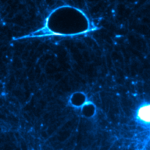Lien vers Pubmed [PMID] – 29362425
Sci Rep 2018 Jan;8(1):1410
The regulation of Rac1 by HACE1-mediated ubiquitination and proteasomal degradation is emerging as an essential element in the maintenance of cell homeostasis. However, how the E3 ubiquitin ligase activity of HACE1 is regulated remains undetermined. Using a proteomic approach, we identified serine 385 as a target of group-I PAK kinases downstream Rac1 activation by CNF1 toxin from pathogenic E. coli. Moreover, cell treatment with VEGF also promotes Ser-385 phosphorylation of HACE1. We have established in vitro that HACE1 is a direct target of PAK1 kinase activity. Mechanistically, we found that the phospho-mimetic mutant HACE1(S385E), as opposed to HACE1(S385A), displays a lower capacity to ubiquitinate Rac1 in cells. Concomitantly, phosphorylation of Ser-385 plays a pivotal role in controlling the oligomerization state of HACE1. Finally, Ser-385 phosphorylated form of HACE1 localizes in the cytosol away from its target Rac1. Together, our data point to a feedback inhibition of HACE1 ubiquitination activity on Rac1 by group-I PAK kinases.

